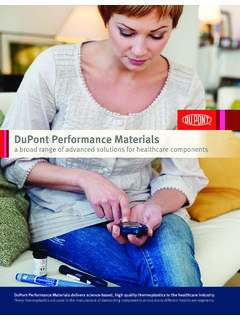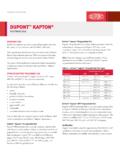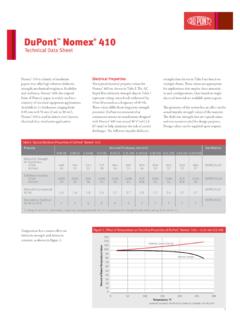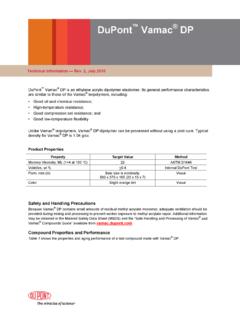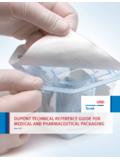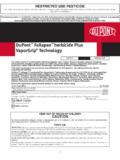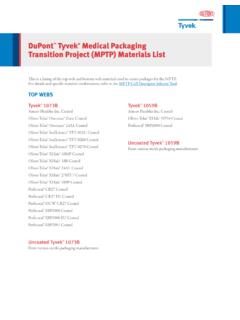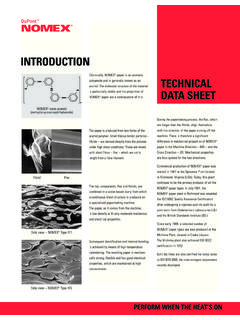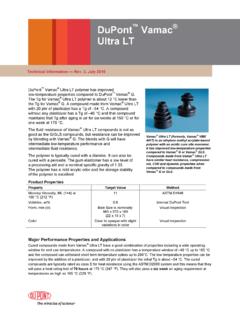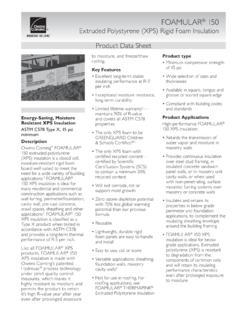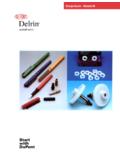Transcription of Hytrel® Product Information - DuPont
1 Product Information polyester elastomerHytrel Rheology and HandlingHytrel polyester elastomers are true thermoplasticpolymers that are processed using conventionalthermoplastic techniques. They are semicrystallinematerials characterized by relatively sharp meltingpoints, temperature-sensitive viscosities, and,except for some low hardness grades, bulletin reviews the melt characteristics of thevarious types of Hytrel and the effects of melttemperature and shear rate on the shear viscosity,and compares the melt rheology of Hytrel with thatof various other thermoplastic polymers. In addi-tion, the effects of moisture are reviewed, andsuggested drying procedures are given along withrecommendations on the use of CharacteristicsMelting characteristics of Hytrel thermoplasticelastomer as determined by differential scanningcalorimetry using ASTM Method D1238 are showninTable 1. The melt temperature at the die shouldalways be equal to or greater than the temperatureat which the polymer is completely 1 Thermal Properties of HytrelMelting TemperatureMelt CompleteCrystallization Temperature(Peak of Endotherm),(Extrapolated End Point),(Peak of Exotherm),Type of Hytrel C ( F) C ( F) C ( F)High ProductivityG3548W156 (313)180 (356)107 (225)G4074170 (338)190 (374)120 (248)G4078W170 (338)190 (374)120 (248)G4774, G4778208 (406)225 (437)170 (338)G5544215 (419)230 (446)173 (343)High Performance4056150 (302)170 (338)70 (158)4069193 (379)210 (410)112 (234)4556193 (379)220 (428)115 (239)5526203 (397)220 (428)147 (297)5556203 (397)220 (428)145 (293)6356211 (412)230 (446)155 (311)7246218 (424)232 (450)162 (324)8238223 (433)235 (455)170 (338)Specialty3078170 (338)200 (392)78 (172)5555HS203 (397)216 (421)166 (330)HTR4275BK196 (385)213 (415)173 (343)HTR5612BK196 (385)213 (415)173 (343)HTR6108168 (334)193 (379)66 (151)HTR8068169 (336)
2 185 (365)140 (284)HTR8139LV192 (378)202 (396) HTR8171150 (302)188 (370) HTR8206200 (392)223 (433) HTY-401 (R2)2 Melt RheologyThe effect of shear rate on viscosity at typicalprocessing temperatures for the basic types ofHytrel is shown in Figure 1. The viscosity versusshear rate curves for polymers of Hytrel are rela-tively flat, especially at low shear rates. Viscositydoes not decrease with increasing shear rate asmuch as for some other polymers. This means thatthe resistance to flow of polymers of Hytrel withincreases in screw or ram speed may be somewhatgreater than experienced with some other poly-mers. This can result in higher torque or injection-pressure effect of temperature change on polymer meltviscosity for shear rates of 100 and 1000 sec 1 areshown in Figures 2 and 3, respectively. A signifi-cant change in melt viscosity can be effected by anominal change in melt temperature. Therefore,injection molding processing temperatures areoften increased to reduce viscosity and facilitatemold filling.
3 Conversely, in extrusion the melttemperature can be decreased to provide greatermelt strength for dimensional stability of effect of injection pressure on melt flow ofHytrel through long narrow channels is shown inFigures 4 and 5. Increases in flow can also beattained by increasing melt or mold of the rapid crystallization rate and viscos-ity/shear rate characteristics of Hytrel, relativelyhigh pressures or high melt temperatures are re-quired to fill long shallow cavities, especiallybelow mm (1/16 in) cavity melt viscosity characteristics of Hytrel enablethese polymers to be used in a wide range of pro-cessing techniques, from low shear operations (suchas rotational molding) to medium and high shearoperations (such as extrusion and injection mold-ing). Very high viscosity grades, HTR5612BK andHTR4275BK are designed primarily for blowmolding and extrusion. Figure 6 compares the meltviscosity versus temperature relationships forpolymers of Hytrel with various other , C ( F)Hytrel G3548W190 (374)Hytrel G4074200 (392)Hytrel G4774230 (446)Hytrel G5544230 (446)Hytrel 3078190 (374)Hytrel 4056190 (374)Hytrel 4069230 (446)Hytrel 4556230 (446)Hytrel 5526230 (446)Hytrel 5556230 (446)Hytrel 6356230 (446)Hytrel 7246240 (464)HTR4275BK230 (446)HTR5612BK230 (446)HTR6108190 (374)HTR8068190 (374)HTR8171190 (374)Figure 1.
4 Melt Viscosity at Processing Temperature11031021010102103104104 Hytrel 4056 HTR6108 Hytrel 5526 Hytrel G4074 Hytrel G4774 Hytrel G5544 HTR8171 Hytrel 3078 Hytrel 4069 Hytrel 4556 Hytrel 5556 Hytrel 6356 Hytrel 7246 Apparent Viscosity, Pa secShear Rate, sec 1{{{Hytrel G3548 WHTR8068 HTR5612BK HTR4275BK}3 Figure 3. Shear Melt Viscosity versus Temperatureat a Shear Rate of 1000 sec 1 Figure 4. Snake Flow at Processing TemperatureFigure 5. Snake Flow at Processing Temperature7006005004003002005,00010,000 15,00020,00025201510 Channel Cross-section mm x mm ( in x in)Hytrel 5526 at 230 C Hytrel G4074 at 200 C Hytrel G3548W at 190 CHytrel 4056 at 190 C Hytrel 5556 at 230 C Hytrel 6356 at 230 C Hytrel 7246 at 240 C Hytrel G4774 at 230 C Hytrel G5544 at 230 C Flow, mmFlow, in{{Injection Pressure, psi200100010505,00010,00015,00020,000 Hytrel 4056 at 190 C Hytrel 5556 at 230 C Hytrel 6356 at 230 C Hytrel 7246 at 240 C Hytrel G4774 at 230 C Hytrel G5544 at 230 C Channel Cross-section mm x mm ( in x in)Hytrel G3548W at 190 C Hytrel G4074 at 200 C Hytrel 5526 at 230 CInjection Pressure, psiFlow, mm{{Flow, inFigure 2.}}}}}}
5 Shear Melt Viscosity versus Temperatureat a Shear Rate of 100 sec 1104103102190 (374)200 (392)210 (410)220 (428)230 (446)240 (464)250 (482)260 (500)HTR4275BK HTR5612 BKHytrel 5526 Hytrel G3548 WHytrel G4774 Hytrel G5544 Hytrel 4556 Hytrel 5556 Hytrel 6356 Hytrel 7246 Melt Temperature, C ( F)Apparent Viscosity, Pa sec{{HTR8171 Hytrel 3078{Hytrel 4069 HTR8068 Hytrel G4074 Hytrel 4056 HTR6108104103102190 (374)200 (392)210 (410)220 (428)230 (446)240 (464)250 (482)260 (500)HTR4275BK HTR5612 BKHytrel 5526 Hytrel G4074 Hytrel G3548 WHytrel 4556 Hytrel 5556 Hytrel 6356 Hytrel 7246 Hytrel G4774 Hytrel G5544 Melt Temperature, C ( F)Apparent Viscosity, Pa sec}{{{HTR8171 HTR8068 Hytrel 4056 HTR6108 Hytrel 40694 Figure 6. Apparent Melt Viscosity versus Temperature at a Shear Rate of 1000 sec 1360400440480520560180200220240260280300 10310486428642103102 8642864210210 Delrin 500 (acetal)Apparent Viscosity, PApparent Viscosity, Pa secMelt Temperature, CDelrin 100 (acetal)Hytrel 4056 Hytrel G3548 WHytrel G4074 Hytrel 5526 Zytel 42 (nylon)Zytel 101 (nylon)Alathon 2005 (polyethylene)Alathon 7240 (polyethylene)Hytrel 5556 Hytrel 6356 Hytrel 7246{Melt Temperature, FHytrel G4774 Hytrel G5544 {5 Handling PrecautionsAll safety practices normally followed in the han-dling and processing of thermoplastic polymersshould be followed for Hytrel polyester polymer is not hazardous under normal ship-ping and storage conditions.}}}}}}}
6 During processing,particularly if recommended temperatures andholdup times are exceeded to any great degree,Hytrel may degrade and decompose with evolutionof gaseous products. Potential hazards from thesegaseous decomposition products include blow-back through the hopper, fire, and exposure totoxic vapors (principally tetrahydrofuran). As withall thermoplastics, thermal burns from contact withmolten polymer are a potential hazard. Beforeprocessing Hytrel, read bulletin Handling andProcessing Precautions for Hytrel, and observe theprecautions recommended ingredients or additives may presenthazards during handling and use. Before proceedingwith any compounding or processing work, consultand follow label directions and handling precau-tions from suppliers of all ingredients, as per specific processing recommendations, pleaserefer to the following publications:BulletinTitleHYT-201 Handling & Processing Precautionsfor HytrelH-33430 Hytrel Injection Molding GuideHYT-403 (R2)Extrusion of HytrelHYT-409 (R1)Melt CastingHYT-451 (R1)Rotational Molding of HytrelPolyester ElastomersHYT-452 (R1)Blown Film of Hytrel PolyesterElastomersDryingHytrel polyester elastomer must be dried prior toprocessing.
7 It is critical to ensure that the resin isdry during processing to make quality parts thatwould give good service is resistant to hydrolysis. It does not reactwith moisture in the air, but will absorb the mois-ture if left exposed. Equilibrium moisture levels asdetermined by ASTM D570 depend on grade (seeTable 2).At temperatures substantially above the meltingpoint, excess moisture causes hydrolytic degrada-tion of the polymer. Such degradation results inpoor physical properties and brittleness. No visualdefects may be apparent but poor in-service perfor-mance can occur, particularly at low , no degradation of the polymer or imper-fections in the molding or extrusion occur if themoisture content is less than , the maximummoisture specification for all grades of dry polymer is subjected to 50% relativehumidity, moisture increase occurs in about2 hr, whereas at 100% relative humidity, it occursin less than 1 hr (see Figure 7). Therefore, pelletsso exposed should be redried before drying Hytrel, dehumidified air ovens arerecommended.
8 Effective drying with such ovenstakes place in 2 3 hr at 100 C (212 F) or overnightat 70 C (158 F).* Drying ovens without dehumidi-fiers may be used but will require 4 6 hr or more,depending on the quantity being dried. Even then,these ovens may not be adequate during periods ofhigh humidity.* It is critical to ensure that the dehumidifying medium is dry prior tothe drying of 2 Equilibrium Moisture Levels of HytrelEquilibrium MoistureType of HytrelLevel, % after 24 hrHigh , 7. Moisture Absorption at AmbientTemperature Hytrel 5556 Figure 8. Drying with Dehumidified Air Hytrel 124 6 10100%RH50%RHTime, hrMoisture Gain, wt% Time, minMoisture Content, %Universal Dynamics Corp. PD-3 Lab Hopper Dryer Circulating Air Temperature: 93 C (200 F) Flow: m3/min (20 cfm) Dew Point: 0 C (32 F) (Ambient Temp.) 46 C ( F) Batch Size: kg (40 lb) RegrindThe unusually good melt stability and completelythermoplastic nature of Hytrel allow use of scrapmoldings and extrusions.
9 Hytrel can be regroundand blended with virgin polymer at a level up to50%. Keep the heat history of the regrind as low aspractical to maintain the high quality of the poly-mer. If a higher level of rework is used, exercisecare to ensure that it is not degraded and is freefrom foreign matter. To prevent any contaminationthe grinder should be thoroughly cleaned in flow rate checks are a practical way to moni-tor quality of regrind on representative for usage levels of regrind basedon melt flow rate are shown in Table flow rate, in effect, measures restricted flowof molten polymer and thus inversely relates toviscosity. A range of typical values for variousgrades of Hytrel are given in Table 4. The higherthe index, the lower the viscosity, and, therefore,the molecular weight thus it is an indication ofpolymer degradation. As an example from Table 3,up to 50% of the feedstock of Hytrel 4056 can bereground provided that the regrind has a melt indexof 8 g/10 min or less.
10 Other grades of Hytrel willfollow similar scrap into chips approximately the same sizeas the original pellets. Use a scrap grinder withwell adjusted, sharp knives shaped for polyethylenecutting to produce clean, sharp regrind. Size reduc-tion is accomplished by cutting, not by fracture all regrind and blend well with virgin polymerto ensure uniform 3 Recommended Usage Levels for Regrind of HytrelMax. AllowableMelt Flow RateMax. RegrindMelt Flow Rate of Regrind,Type of HytrelSpec. Range, g/10 min*Usage, %g/10 at 190 C (374 F)2510508552614 21 at 220 C (428 F)2531502555565 9 at 220 C (428 F)2515501163567 at 230 C (446 F) 15 at 240 C (464 F)252150175555HS7 10 at 220 C (428 F)25155012*ASTM Method D1238, kg loadTable 4 Typical Melt Flow Rate Values of HytrelMelt Flow Rate,Test Temperature,Type of Hytrelg/10 min, kg load C ( F)High ProductivityG3548W10190 (374) (374) (374)G4774, G477812230 (446) (446)High (374) (428)455612230 (446)552618220 (428)55567220 (428) (446) (464)8238 Specialty30785190 (374) (428) (446)HTR5612BK3230 (446) (374) (374) (446)HTR81719190 (374)HTR820612230 (446)(11/93) 236359A Printed in [Replaces: E-84283]Reorder No.
